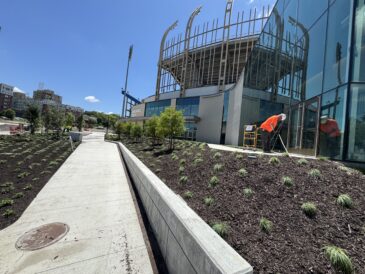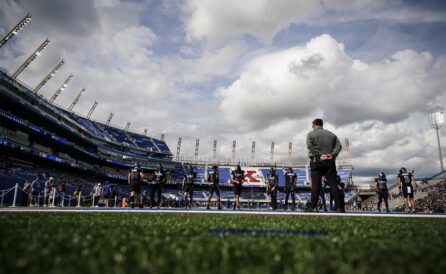The $300 million gift that Kansas Athletics received from benefactor David Booth is every bit as momentous a donation as KU made it sound in August.
It is the largest gift ever given to the University of Kansas and one of the biggest ever in college athletics; it is, as athletic director Travis Goff calls it, a “fully funded endowment that’s been gifted to us” that will fuel KU for decades going forward; and it is, most immediately, a crucial step in the ongoing reconstruction of the stadium that bears Booth’s name, as it contributes $75 million toward the second phase of the Gateway project.
It is not, however — as some seem to have construed it — an immediate player acquisition tool for KU’s sports teams. That is because the gift is not a lump sum granted to the athletic department, and it will not in fact contribute to the department’s operating budget at all for years to come.
“I think part of the opportunity is to educate, in a way, to where there’s not a misunderstanding that this was a massive one-off cash gift,” Goff said at a recent KU Athletics board of directors meeting. “That’s just not the way these kinds of sophisticated and certainly exceptional gifts work. And so the valuation has a long-term lens on it.”
The long-term nature of Booth’s gift was in some sense clear as soon as it was announced, with a press release that referred to it as “a stream of income that will strengthen Kansas Athletics across generations.” At the board meeting, though, Goff provided new information about the pace at which the department will receive that income.
It takes the form of annual distributions. Importantly, KU will use those distributions for the Gateway project until they have totaled $75 million, or a quarter of the total gift. Goff said it’s not clear because of “a variety of factors” how big each distribution will be, but he estimated that the first six or seven years of distributions could contribute to the $75 million benchmark. In other words, each annual sum is in the range of $10.7 to $12.5 million.
By the time that first set of distributions has elapsed, the Gateway project, at least as the world currently understands it, should be well in the rearview mirror, as KU officials have been targeting 2028 as the year they expect to begin to reap budget surpluses from the renovated stadium, conference center, hotel, apartment complex and more. If KU receives the first Booth payment in the fiscal year 2026, which ends on June 30, 2026, it will therefore move on from the initial $75 million phase of Booth’s gift by either June 30, 2031, or June 30, 2032.
“The balance, as we think about the distributions in the years beyond that, (is) unrestricted to athletics, meaning we don’t know what the need will be, we don’t know what the future state necessarily will be,” Goff said. “As we think about looking out to really a quote-unquote guaranteed eight-figure annual distribution from this gift, we can all really reflect on the impact of that.”
The “incredible opportunity and upside,” as Goff put it, lies beyond the conclusion of that first $75 million chunk.
If the size of the annual donations is $12.5 million, the gift will continue for 24 years in total. If it’s $10.7 million, it will last for 28. KU may well still be receiving David Booth’s money in the 2050s.
Now, Goff has described the gift as one that will provide “differentiating resources in a climate where everybody’s fighting and scratching to be competitive and to fuel their programs.” But by the time KU gets to use Booth’s money for whatever it likes, it may not be in a climate that remotely resembles the current one.
KU described the value of the non-Gateway $225 million in its press release as follows: “With the advent of revenue sharing and the continued changes in NCAA and conference dynamics, (Booth’s) generosity will help enable KU to take the next step in cementing itself as a national leader in college athletics.”
The KU athletic department is spending $18.9 million on revenue sharing and Alston awards during the fiscal year 2026, according to documentation it shared during the board meeting. If, hypothetically, it had a chunk of Booth’s money for something other than the stadium this year, it could knock out nearly two thirds of those costs.
Instead, by the time KU Athletics gets to fund itself, rather than the stadium, with Booth’s donation, the revenue-sharing cap will likely have increased dramatically.
For 2025-26, schools can share up to $20.5 million directly with their student-athletes. (If they furnish extra scholarships, as KU does, those costs count against the cap.) For each of the next two years, the cap will increase by 4%, meaning it will be $22.2 million in 2027-28. The cap will be reevaluated “every three years over the duration of the 10-year settlement period,” according to the College Sports Commission.
Hypothetically, if the percentage doesn’t change, schools could be furnishing $25.9 million for the 2031-32 academic year and $27.0 million for 2032-33 — around when KU Athletics starts using Booth’s money for its own non-stadium purposes — but who knows what else might have changed in college athletics by that point. As KU Athletics Chief Financial Officer Pat Kaufman said at the board meeting, KU didn’t know revenue sharing was about to happen when it kicked off its stadium project. That took place over a much shorter period of time than between 2025 and 2031.
To be clear, this isn’t to diminish the value of $75 million to KU’s stadium efforts in the near future. In August, KU characterized the $94.6 million it received in a variety of financial incentives from the Lawrence City Commission as about 27% of the cost of the second phase. That means Booth’s gift — gradual though it may be — would provide another 21% on its own. With $25 million more inbound from Paul and Linda DeBruce, that all amounts to well over half the funding for the phase that KU received just in the month of August.
Also, quite obviously, even though KU Athletics isn’t using Booth’s money for its internal operations like revenue sharing in the near term, the time and effort it would otherwise have to spend on accruing $75 million for the stadium project from a variety of sources can instead be spent on other things. That means less donor fatigue and, even if fundraisers are still working on funding the stadium project to some extent, more opportunities for them to garner additional donations for revenue sharing, as well as name, image and likeness deals that can go beyond the $20.5 million cap.
Booth’s gift is evidently a long-term boost to KU Athletics, but there’s a reason why it won’t factor into the department’s annual budgets any time soon. It is not a sudden cash infusion but indeed a “stream of income,” and the faucet apparently doesn’t turn on, for non-stadium purposes, until the 2030s.

